最新小升初英语介词的用法归纳
- 格式:doc
- 大小:148.50 KB
- 文档页数:10
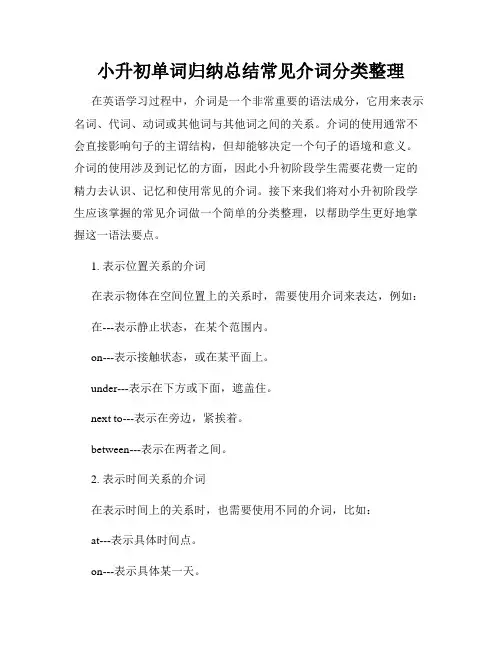
小升初单词归纳总结常见介词分类整理在英语学习过程中,介词是一个非常重要的语法成分,它用来表示名词、代词、动词或其他词与其他词之间的关系。
介词的使用通常不会直接影响句子的主谓结构,但却能够决定一个句子的语境和意义。
介词的使用涉及到记忆的方面,因此小升初阶段学生需要花费一定的精力去认识、记忆和使用常见的介词。
接下来我们将对小升初阶段学生应该掌握的常见介词做一个简单的分类整理,以帮助学生更好地掌握这一语法要点。
1. 表示位置关系的介词在表示物体在空间位置上的关系时,需要使用介词来表达,例如:在---表示静止状态,在某个范围内。
on---表示接触状态,或在某平面上。
under---表示在下方或下面,遮盖住。
next to---表示在旁边,紧挨着。
between---表示在两者之间。
2. 表示时间关系的介词在表示时间上的关系时,也需要使用不同的介词,比如:at---表示具体时间点。
on---表示具体某一天。
in---表示年、月、季节等一段时间。
for---表示一段时间的持续。
since---表示自从某一时间点起开始。
3. 表示原因、目的和结果的介词在表示原因、目的和结果方面,介词也有着不同的用法,比如:because of---表示原因。
in order to---表示目的。
as a result of---表示结果。
4. 表示方式和比较的介词有些介词在表示方式、比较时有特殊的用法,比如:like---表示类似于。
as---表示作为,如同。
than---表示比较。
5. 表示从属关系的介词在表示从属关系时,通常会使用以下介词,比如:of---表示所属关系,材料组成等。
from---表示来源,出处。
to---表示方向,目的地等。
除了以上列举的介词,英语中还有很多其他常用的介词。
希望同学们能够通过不断的积累和实践,逐渐熟练运用这些介词,从而提高自己的语言表达能力。
总之,介词在英语中扮演着十分重要的角色,掌握好常见的介词用法将对学生的语言学习产生积极的影响。
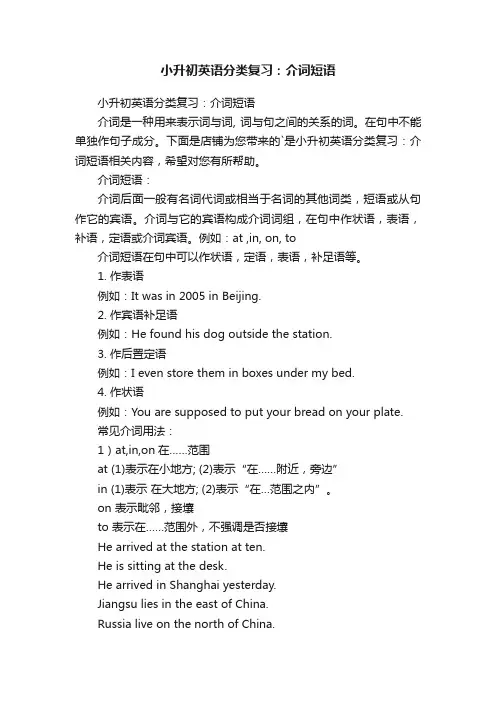
小升初英语分类复习:介词短语小升初英语分类复习:介词短语介词是一种用来表示词与词, 词与句之间的关系的词。
在句中不能单独作句子成分。
下面是店铺为您带来的`是小升初英语分类复习:介词短语相关内容,希望对您有所帮助。
介词短语:介词后面一般有名词代词或相当于名词的其他词类,短语或从句作它的宾语。
介词与它的宾语构成介词词组,在句中作状语,表语,补语,定语或介词宾语。
例如:at ,in, on, to介词短语在句中可以作状语,定语,表语,补足语等。
1. 作表语例如:It was in 2005 in Beijing.2. 作宾语补足语例如:He found his dog outside the station.3. 作后置定语例如:I even store them in boxes under my bed.4. 作状语例如:You are supposed to put your bread on your plate.常见介词用法:1)at,in,on在……范围at (1)表示在小地方; (2)表示“在……附近,旁边”in (1)表示在大地方; (2)表示“在…范围之内”。
on 表示毗邻,接壤to 表示在……范围外,不强调是否接壤He arrived at the station at ten.He is sitting at the desk.He arrived in Shanghai yesterday.Jiangsu lies in the east of China.Russia live on the north of China.Fujian is to the south of Jiangsu Province.2)above, over, on 在……上above 指在……上方,不强调是否垂直,与 below相对;over指垂直的上方,与under相对,但over与物体有一定的空间,不直接接触。
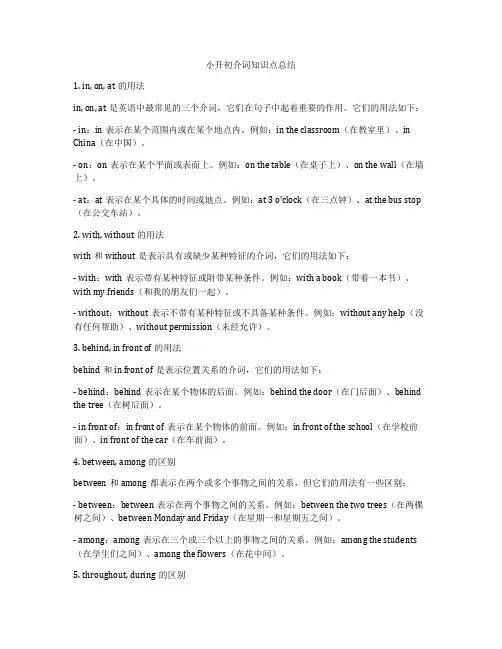
小升初介词知识点总结1. in, on, at的用法in, on, at是英语中最常见的三个介词,它们在句子中起着重要的作用。
它们的用法如下:- in:in表示在某个范围内或在某个地点内。
例如:in the classroom(在教室里)、in China(在中国)。
- on:on表示在某个平面或表面上。
例如:on the table(在桌子上)、on the wall(在墙上)。
- at:at表示在某个具体的时间或地点。
例如:at 3 o'clock(在三点钟)、at the bus stop (在公交车站)。
2. with, without的用法with和without是表示具有或缺少某种特征的介词,它们的用法如下:- with:with表示带有某种特征或附带某种条件。
例如:with a book(带着一本书)、with my friends(和我的朋友们一起)。
- without:without表示不带有某种特征或不具备某种条件。
例如:without any help(没有任何帮助)、without permission(未经允许)。
3. behind, in front of的用法behind和in front of是表示位置关系的介词,它们的用法如下:- behind:behind表示在某个物体的后面。
例如:behind the door(在门后面)、behind the tree(在树后面)。
- in front of:in front of表示在某个物体的前面。
例如:in front of the school(在学校前面)、in front of the car(在车前面)。
4. between, among的区别between和among都表示在两个或多个事物之间的关系,但它们的用法有一些区别:- between:between表示在两个事物之间的关系。
例如:between the two trees(在两棵树之间)、between Monday and Friday(在星期一和星期五之间)。
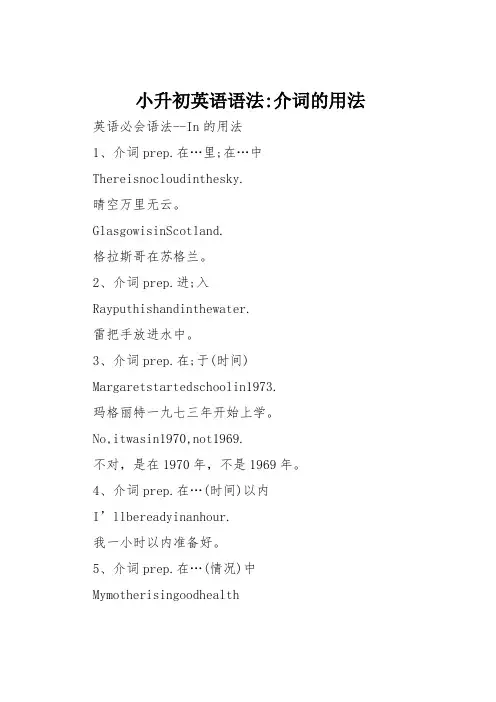
小升初英语语法:介词的用法英语必会语法--In的用法1、介词prep.在…里;在…中Thereisnocloudinthesky.晴空万里无云。
GlasgowisinScotland.格拉斯哥在苏格兰。
2、介词prep.进;入Rayputhishandinthewater.雷把手放进水中。
3、介词prep.在;于(时间) Margaretstartedschoolin1973.玛格丽特一九七三年开始上学。
No,itwasin1970,not1969.不对,是在1970年,不是1969年。
4、介词prep.在…(时间)以内I’llbereadyinanhour.我一小时以内准备好。
5、介词prep.在…(情况)中Mymotherisingoodhealth我的母亲身体很好。
Emmawasintears.埃玛哭了。
6、介词prep.穿;戴Thepolicemanisinuniform.警察穿着制服。
Shedresseshiminhisnewclothes.她给他穿新衣服。
7、介词prep.在…(环境)下Wewalkedintherain.我们冒雨行走。
Theysleptintheshade.他们睡在树荫下。
8、介词prep.以…(方式),用…(语言) HespokeinItalian.他讲话用意大利语。
TheytalkedinEnglish.他们用英语交谈。
Pleasewriteinpencil,notinink.请用铅笔写,不要用钢笔写。
TheletterwaswritteninFrench.信是用法文写的。
9、介词prep.从事(职业);参加(活动)He’sinthearmy.他在军队里10、副词adv.向内;进入Hejustlookedinforamoment.他只是(在门外)往里头看了看。
Comein.进来。
Stepin,please.请进来。
11、副词adv.在内;在家;在办公室Isyourbrotherinorhashegonetothematch?你弟弟是在家还是看球赛去了?”IsMr.Smithin?”“No,he’sgoneoutforlunch!”“史密斯先生在家吗?”“不在,他出去吃午饭去了。
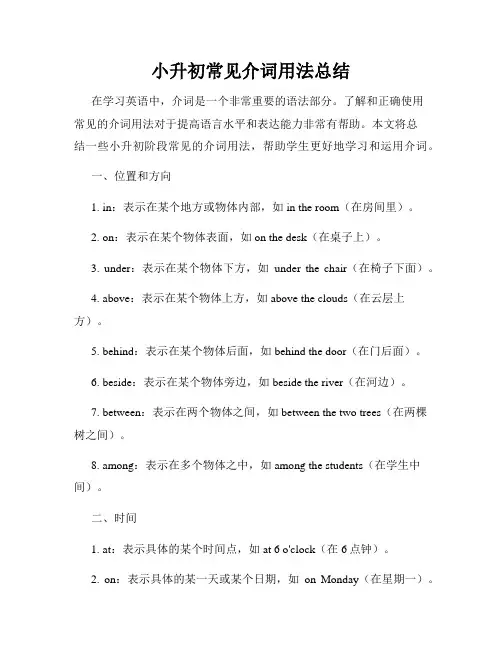
小升初常见介词用法总结在学习英语中,介词是一个非常重要的语法部分。
了解和正确使用常见的介词用法对于提高语言水平和表达能力非常有帮助。
本文将总结一些小升初阶段常见的介词用法,帮助学生更好地学习和运用介词。
一、位置和方向1. in:表示在某个地方或物体内部,如in the room(在房间里)。
2. on:表示在某个物体表面,如on the desk(在桌子上)。
3. under:表示在某个物体下方,如under the chair(在椅子下面)。
4. above:表示在某个物体上方,如above the clouds(在云层上方)。
5. behind:表示在某个物体后面,如behind the door(在门后面)。
6. beside:表示在某个物体旁边,如beside the river(在河边)。
7. between:表示在两个物体之间,如between the two trees(在两棵树之间)。
8. among:表示在多个物体之中,如among the students(在学生中间)。
二、时间1. at:表示具体的某个时间点,如at 6 o'clock(在6点钟)。
2. on:表示具体的某一天或某个日期,如on Monday(在星期一)。
3. in:表示在某段时间内或月份,如in the morning(在早上)、in July(在七月)。
4. during:表示在某一段时间内,如during the summer vacation(在暑假期间)。
5. for:表示持续的时间,如for two hours(持续两个小时)。
三、原因和目的1. because of:表示因为某个原因,如because of the rain(因为下雨)。
2. due to:表示由于某个原因,如due to the bad weather(由于天气恶劣)。
3. for:表示出于某个目的,如for fun(为了娱乐)。
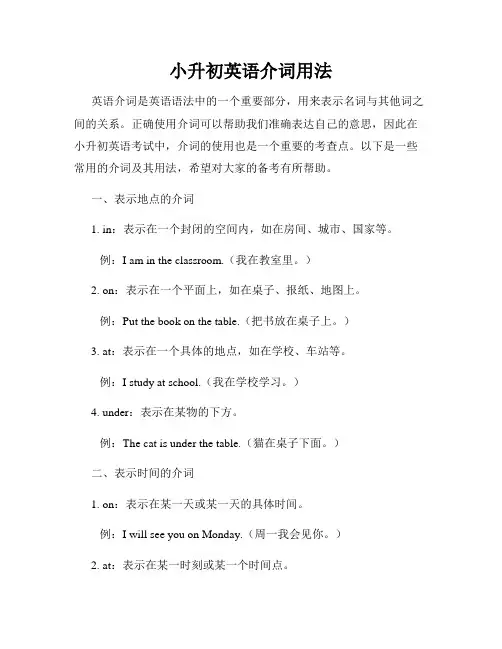
小升初英语介词用法英语介词是英语语法中的一个重要部分,用来表示名词与其他词之间的关系。
正确使用介词可以帮助我们准确表达自己的意思,因此在小升初英语考试中,介词的使用也是一个重要的考查点。
以下是一些常用的介词及其用法,希望对大家的备考有所帮助。
一、表示地点的介词1. in:表示在一个封闭的空间内,如在房间、城市、国家等。
例:I am in the classroom.(我在教室里。
)2. on:表示在一个平面上,如在桌子、报纸、地图上。
例:Put the book on the table.(把书放在桌子上。
)3. at:表示在一个具体的地点,如在学校、车站等。
例:I study at school.(我在学校学习。
)4. under:表示在某物的下方。
例:The cat is under the table.(猫在桌子下面。
)二、表示时间的介词1. on:表示在某一天或某一天的具体时间。
例:I will see you on Monday.(周一我会见你。
)2. at:表示在某一时刻或某一个时间点。
例:The party starts at 8 o'clock.(派对从8点开始。
)3. in:表示在某一段时间内。
例:I will go on vacation in July.(我七月份去度假。
)4. for:表示一段持续的时间。
例:I have been studying English for five years.(我已经学习英语五年了。
)三、表示方式的介词1. by:表示通过某种方式或方法。
例:I go to school by bus.(我乘公交车去学校。
)2. with:表示使用某种工具或伴随的状态。
例:He writes with a pen.(他用钢笔写字。
)四、表示原因的介词1. because of:表示因为某个原因。
例:I am happy because of your help.(因为你的帮助,我很开心。
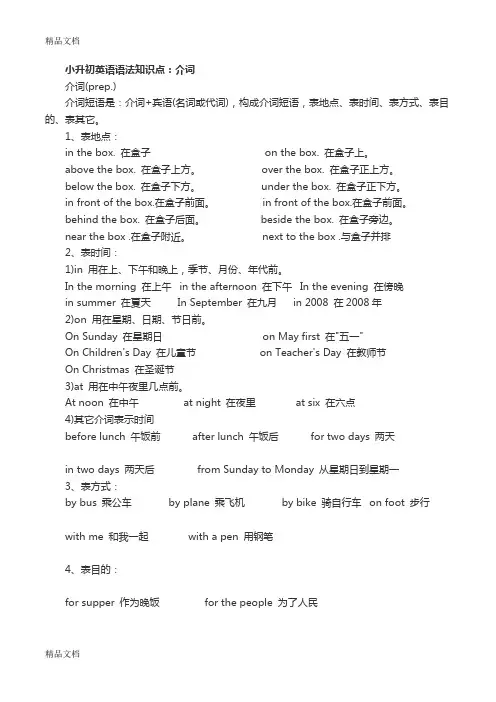
小升初英语语法知识点:介词介词(prep.)介词短语是:介词+宾语(名词或代词),构成介词短语,表地点、表时间、表方式、表目的、表其它。
1、表地点:in the box. 在盒子 on the box. 在盒子上。
above the box. 在盒子上方。
over the box. 在盒子正上方。
below the box. 在盒子下方。
under the box. 在盒子正下方。
in front of the box.在盒子前面。
in front of the box.在盒子前面。
behind the box. 在盒子后面。
beside the box. 在盒子旁边。
near the box .在盒子附近。
next to the box .与盒子并排2、表时间:1)in 用在上、下午和晚上,季节、月份、年代前。
In the morning 在上午 in the afternoon 在下午 In the evening 在傍晚in summer 在夏天 In September 在九月 in 2008 在2008年2)on 用在星期、日期、节日前。
On Sunday 在星期日on May first 在"五一"On Children's Day 在儿童节 on Teacher's Day 在教师节On Christmas 在圣诞节3)at 用在中午夜里几点前。
At noon 在中午at night 在夜里 at six 在六点4)其它介词表示时间before lunch 午饭前 after lunch 午饭后for two days 两天in two days 两天后 from Sunday to Monday 从星期日到星期一3、表方式:by bus 乘公车by plane 乘飞机by bike 骑自行车 on foot 步行with me 和我一起 with a pen 用钢笔4、表目的:for supper 作为晚饭for the people 为了人民5、表其它:like this象这样to school 到学校of China 关于中国 except Tom 除了Tom without Tom没有汤姆一句话语法:早、午、晚要用in,年、月、季节、衣、冒in,将来时态in...以后,小处at大处in,At 午夜点与分,日期、星期、节日on。


小升初重难点整理介词的用法归纳介词在英语中扮演着非常重要的角色,它能够连接名词、代词、动词或者形容词等词语,帮助我们表达时间、地点、方式、原因等关系。
在小升初的英语考试中,介词的用法是一个重要的考点。
本文将对小升初英语考试中常见的介词用法进行整理和归纳。
一、表示位置和方向的介词1. in- 表示在某个大区域之内:in the room(在房间里)- 表示在某个城市或国家:in Beijing(在北京)- 表示在某个交通工具上:in the car(在车里)2. on- 表示在某个平面上:on the table(在桌子上)- 表示在某个日期或时间:on Monday(在星期一)3. at- 表示在某个点上:at the bus stop(在公交车站)- 表示在某个具体地点:at the park(在公园)4. under- 表示在某个物体下面:under the bed(在床底下)5. behind- 表示在某个物体后面:behind the tree(在树后面)6. next to- 表示在某个物体旁边:next to the library(在图书馆旁边)7. between- 表示在两个物体之间:between the two buildings(在两个建筑物之间)二、表示时间的介词1. in- 表示在某个年、季度、月等的时间段内:in 2022(在2022年) - 表示在某个时间上午或下午:in the morning(在早上)2. on- 表示在某个具体的日期:on June 1st(在6月1日)- 表示在某个星期几:on Sunday(在星期天)3. at- 表示在某个具体的时间点:at 9 o'clock(在9点钟)三、表示原因的介词1. because of- 表示因为某个原因:I couldn't go to the party because of the rain.(因为下雨,我不能去参加聚会)2. due to- 表示由于某个原因:The delay of the flight was due to the bad weather.(航班延误是由于天气恶劣)四、表示方式的介词1. by- 表示通过某种方式:by bus(乘坐公交车)- 表示凭借某种手段:by using a calculator(通过使用计算器)2. with- 表示使用某种工具或方式:write with a pen(用钢笔写)五、表示比较和区别的介词1. like- 表示像某人或某物:She looks like her mother.(她长得像她妈妈) - 表示和...相似:He plays basketball like a professional.(他打篮球像个职业球员)2. unlike- 表示和...不同:Unlike his brother, he doesn't like sports.(和他哥哥不同,他不喜欢运动)六、表示目的的介词1. for- 表示为了某个目的:I bought a gift for my friend.(我给朋友买了一份礼物)2. to- 表示朝着某个目的地或目标:I am going to school.(我正要去学校)总结:介词在英语中的用法是一个重要的语法考点,对于小升初的考生来说尤为关键。
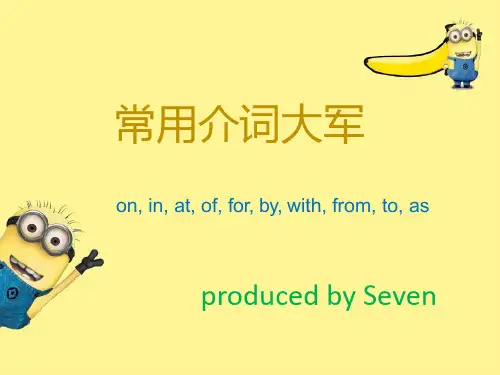

小升初重要知识点梳理常见介词的用法与搭配介词在英语中是一类重要的词性,它们用来表达名词、代词、动词或形容词与其他词语之间的关系。
在小升初考试中,掌握常见介词的用法与搭配是非常重要的。
本文将对常见介词的用法进行梳理,以帮助同学们更好地掌握小升初英语考试的关键知识点。
1. in介词"in"表示在某个地方或范围内,常用于以下几种情况:(1)表示地点:in the park(在公园里), in the classroom(在教室里)(2)表示时间:in the morning(在早上), in June(在六月)(3)表示语言或领域:in English(用英语), in science(在科学领域)(4)表示状态或情况:in trouble(处于困境), be in a hurry(匆忙)2. on介词"on"表示在某个表面或时间上,常用于以下几种情况:(1)表示地点:on the table(在桌子上), on the beach(在海滩上)(2)表示日期或星期:on Monday(在星期一), on the 15th of March(在三月十五日)(3)表示媒介或交通工具:on the radio(通过收音机), on the bus (在公交车上)3. at介词"at"表示在某个具体的地点或时间上,常用于以下几种情况:(1)表示地点:at school(在学校), at the park(在公园)(2)表示具体的时间点:at 2 o'clock(在两点钟), at Christmas (在圣诞节)(3)表示瞬间动作:laugh at(嘲笑), shout at(对...喊叫)4. by介词"by"表示通过某种方式或是靠近某人或某物,常用于以下几种情况:(1)表示方式或方法:go to school by bus(乘公交车去学校), send a message by email(通过电子邮件发送消息)(2)表示靠近:stand by the window(站在窗户边)(3)表示时间或截止日期:by next week(在下周之前), finish the project by Monday(在星期一之前完成项目)5. for介词"for"表示表示目的、理由或是接受某种东西,常用于以下几种情况:(1)表示目的或理由:study for the test(为了考试而学习), apologize for the mistake(为错误道歉)(2)表示接受:buy a gift for my mother(给我妈妈买礼物)6. with介词"with"表示伴随、具有或使用某物,常用于以下几种情况:(1)表示伴随:go to the park with my friends(和我的朋友一起去公园)(2)表示具有:a girl with blue eyes(一位拥有蓝眼睛的女孩)(3)表示使用:write with a pen(用钢笔写)7. to介词"to"表示朝向、目标或是接受,常用于以下几种情况:(1)表示朝向:go to school(去学校), run to the park(跑向公园)(2)表示目标:give the book to me(把书给我)(3)表示接受:send a letter to my friend(给我的朋友寄信)8. from介词"from"表示出发点、来源或是离开某地,常用于以下几种情况:(1)表示出发点:come from Beijing(来自北京), start from home (从家出发)(2)表示来源:receive a gift from my friend(从我的朋友那里收到礼物)(3)表示离开:run from danger(逃离危险)以上是小升初英语中常见介词的用法与搭配。
介词用法总结小升初知识点一、介词的基本概念介词是一种虚词,用来连接名词、代词或动名词与其他词语。
介词通常放在名词、代词或动名词之前,用来说明它们与其他词语之间的关系。
介词一般单独使用,但有时也会与其他介词形成短语,如in front of, because of等。
二、介词的分类介词根据其所表示的意义可以分为几种类型,常见的有时间介词、地点介词、方向介词、原因介词等。
1. 时间介词时间介词用来表示时间上的关系,例如at, on, in, before, after, during, for, since等。
它们的用法如下:- at:用于表示具体的某一天、某个具体的时间点,如at 5 o'clock, at Christmas等。
- on:常用于表示某一天或日期,如on Monday, on May 1st等。
- in:用来表示大范围的时间,如in the morning, in summer等。
也可用于表示月份、季节、年份等,如in April, in 2022等。
- before:表示在某一时间之前,如before lunch, before Christmas等。
- after:表示在某一时间之后,如after dinner, after class等。
- during:表示在某一时间段内,如during the meeting, during the holiday等。
- for:表示持续的时间,如for two hours, for a week等。
- since:表示从某一时刻开始,如since last year, since 9 o'clock等。
2. 地点介词地点介词用来表示地点或位置上的关系,例如in, on, at, by, under, over, behind, in front of 等。
它们的用法如下:- in:用来表示在某一范围内的地点,如in the room, in Beijing等。
小升初介词相关知识点总结一、介词的概念介词是一种虚词,主要用来表示名词或代词与其他词语之间的关系,如时间、地点、原因、目的、方式等,或者在句子中起连接、修饰、修辞和说明等作用。
介词通常位于名词或代词之前,构成介词短语,对名词或代词进行修饰或补充说明。
例如:in the classroom(在教室里)、at 6 o’clock(在六点钟)、for my sister(为了我妹妹)等。
二、介词的用法1. 表示时间关系的介词有:at, in, on, during等。
如:at 7 o’clock(在七点钟)、in January(在一月份)、on Sunday(在星期日)、during the summer(在夏天)。
2. 表示地点关系的介词有:in, on, at, above, below, behind, in front of, near, next to, between等。
如:in the classroom(在教室里)、on the table(在桌子上)、at the bus stop(在公交车站)、above the sky(在天空之上)、below the ground(在地下)、behind the door(在门后)、in front of the building(在建筑物前)、near the park(在公园附近)、next to the river(在河边)、between the two trees(在两棵树之间)。
3. 表示原因、目的、方式、比较等关系的介词有:because of, in order to, by, with, for, like, as, than等。
如:because of the rain(因为下雨)、in order to pass the exam(为了通过考试)、by bus(乘坐公交车)、with my mother(和我妈妈一起)、for example(例如)、like a bird(像一只鸟儿)、as big as an elephant(和大象一样大)、faster than a car(比汽车快)。
专题八介词一、介词的概念介词四表示名词、代词和句中其他词之间关系的词,是虚词,在句中不单独作任何句子成分。
二、介词的分类(一)时间介词at,in,on 1.at多用于表示具体的钟点时刻。
I usually get up at7o’clock.The street is very noisy at night.2.in用于表示一段时间或用于年、月、四季、世纪或泛指一天的上午、下午、晚上等。
In my twentiesIn the morning/afternoon/eveningIn2022In JuneIn spring/summer/autumn/winterIn the21st century3.on表示具体的时期,如星期几、几号或节日前。
On Monday-Sundayon October6thOn the Spring Festival,on Children’s Day,on National Day,on the Mid-AutumnFestivalbefore,after 1.before表示“在……之前”Wash your hands before meals.2.after表示“在……之后”They often do their homework together after school.after,in 1.after“……之后”既可以表示以过去为起点的某一段时间之后,也可以与时间点连用表示将来某个时间之后。
They finished the work after two years.He will come out after6pm.2.in后接一段时间,常用于一般将来时He will graduate from the university in4years.until,by 1.until,在否定句中构成not...until句型,表示“直到……才”;在肯定句中,表示“直到……为止”。
介词介词是表示名词,代词和句中其他词之间关系的词,主要表示地点,位置,时间和方式等。
What can you see in the picture?你在照片里看到了什么?I was born on May 11th.我出生在5月11日。
The library is near the post office.图书馆在邮局附近。
常用介词及用法1. 表示时间的介词。
英语里最常见的时间介词有: at, in , on, before, after和from.(1) at, in 和on 都表示时间。
at 指具体的时间点。
at half past seven. 在七点半。
at eleven o’clockat noon (中午) at that time (那时)in 一般指某一段时间。
in April 在四月份 in the morning/afternoon/evening.In 2013 , in May, 2005(在2005年五月); in three days(三天之后); in Spring; in the 21st century(在21世纪)on指在具体的某一天。
on Sunday. 在星期天。
On April,1st在四月一日on Sunday afternoon 在星期天的早上on a warm morning in April (在四月的一个温暖的早晨)on New Year’s day(新年)(2) before 和after 表示时间的先后顺序。
before 表示“在…..之前”Wash your hands before dinner. 饭前要洗手。
I have to finish my homework before 10 o’clock..我不得不在十点之前做完作业。
after 表示“在….之后”,They often play football after school.他们放学后经常踢足球。
介词(基础篇)1考点一:方位介词方位介词是表示位置和方向的介词.常用的方位介词有on,over,above,under, below,in,at,about,around,behind,between,among,beside,near等.1.on,over和above的用法on,over和above都有“在…上面”的意思,但这三个调在意义上还是有一些区别的。
(1)on表示两个物体的表面相互接触,例如:There is a plant on the desk.书桌上有一株植物。
(植物紧贴着桌面)(2)over表示“在…的正上方”,两个物体表面没有接触,侧如:A lamp hung over the table.桌子上方挂着一盏灯。
(灯和桌面没有接触)(3)above表示一个物体在另一个的上方,但不一定是在正上方,两个物体之间没有接触。
例如:Look!A lot of birds are flying above the trees.看!许多鸟正在树的上空飞。
2.under和below的用法under和below都有“在…下面”的意思,不过这两个词也是有区别的.(1)under表示“在…的正下方”。
例如:There is a cat under the table.桌子下面有一只猫。
(2)below表示"在…的下面",但不强测是否在正下方,例如:Our classroom is below theirs.我们的教室在他们(教室)的下面。
介词(基础篇)2 3.in的用法in表示"在…里面",也可以用来表示在一个很大的空间内。
例如:There are some books in the box箱子里有一些书。
4.at,about和around的用法at表示"在…旁边",about或around表示"在…周围"。
(1)at表示在某物旁边。
介词介词是表示名词,代词和句中其他词之间关系的词,主要表示地点,位置,时间和方式等。
What can you see in the picture?你在照片里看到了什么?I was born on May 11th.我出生在5月11日。
The library is near the post office.图书馆在邮局附近。
常用介词及用法1. 表示时间的介词。
英语里最常见的时间介词有:at, in , on, before, after和from.(1) at, in 和on 都表示时间。
at 指具体的时间点。
at half past seven. 在七点半。
at eleven o’clockat noon (中午)at that time (那时)in 一般指某一段时间。
in April 在四月份in the morning/afternoon/evening. In 2013 , in May, 2005(在2005年五月); in three days(三天之后); in Spring; in the 21st century(在21世纪)on指在具体的某一天。
on Sunday. 在星期天。
On April,1st在四月一日on Sunday afternoon 在星期天的早上on a warm morning in April (在四月的一个温暖的早晨)on New Year’s day(新年)(2) before 和after 表示时间的先后顺序。
before 表示“在…..之前”Wash your hands before dinner. 饭前要洗手。
I have to finish my homework before 10 o’clock..我不得不在十点之前做完作业。
after 表示“在….之后”,They often play football after school.他们放学后经常踢足球。
My father often watches TV after dinner.我爸爸经常在晚饭后看电视。
(3) from 表示时间时,常和to 连用,构成from… to…的结构,表示“从…..到…..”的意思。
He kept on working from seven to twelve last night.他昨晚从起点到12点一直在工作。
I go to school from Monday to Friday.2. 表示方位的介词。
小学阶段常见的方位介词有on, in, at , under, over, above, below, about, around, between 等。
(1) on , over 和above相同点:三者均有“在….上面”的意思。
不同点:on 表示两个物体的表面相互接触。
—Where is the pen ? —It’s on the boxover 表示“在….的正上方”,两个物体的表面没有接触。
above 表示两个物体中一个在另一个的上方,但不一定垂直,两个物体间也没有接触。
There is a book on the desk.桌子上有一本书。
The sky is over our heads.天在我们的头顶上。
The plane is flying above clouds.飞机在云上飞行。
(2)under 和below相同点:两者均表示“在….的下面”的意思。
不同点:under 表示“在….的正下方”,其反义词是over.over underThere is a ball over two boxes.There is a ball under a boxThere is a bridge over the river.河上有座桥。
below 表示“在…..的下面”,但只是低于某一点,不强调是否在正下方。
From the top of the hill, we could see the blue ocean below.我们从山顶上能看到下边的蓝色大海。
The dead sea is below sea level.死海的海面低于海平面。
(3) in 表示位置,意为“在…里面”,也可以用来表示在一个很大的空间内。
Mary works in a bank.玛丽在银行工作。
There isn’t a cloud in the sky.天空中没有一片云。
What’s in the box?He put his hands in his pockets.他把手放入口袋。
(4) at 表示“在某地点”。
I will wait for you at the station.我将在车站等你。
(5) around 和about 均表示“在…周围”。
They sat around the table.他们围着桌子而坐。
We walked about the town.我们在镇周围走。
(6) behind 表示“在…..的后面”。
There is a broom behind the door.门后边有一把扫帚。
(7) in front of 表示“在……的前面”。
There is a new white car in front of the house.那房子前面有一辆白色的新轿车。
(8) between 表示“在两者之间”。
My bedroom is between my two sisters’.我的卧室在两个姐妹的卧室之间。
(9)表示“在某地”时,at后面接小地方,in后接大地方。
如:at home在家at the bus stop在汽车站in China在中国in the world在世界上3. 表示动向的介词。
在英语钟,有一类介词表示一种动态的移动,有“朝着……”和“向着……”的意思。
小学阶段常见的动向介词有into, out of, up, down, from, to, across, through, along等。
(1) into 和out ofInto表示“从外向里”的意思;out of 表示“从里向外”的意思。
I saw them go into the house.我看见他们进了那间房子。
Lily ran out of the classroom.莉莉跑出了教室。
(2) up 和downup 表示“向上”,down 表示“向下”。
We climbed up the mountain to the top.我们爬上了山顶。
She opened the door and went down the stairs.她开了门下楼去了。
(3) across 和through相同点:两者都表示“通过,穿过”的意思。
不同点:across.[ə'krɔs]表示“穿过”这一动作在某个物体的表面进行。
He walked across the road carefully.他小心地穿过马路。
The duck is swimming across the river.这只鸭子正在游过河。
He is swimming across the pool.他正在游过游泳池。
through.[θru:]表示“穿过”这一动作在某个物体的空间内进行。
She walked through the forest alone.她独自一人走过森林。
The train is going through the tunnel(隧道)。
这辆火车正在穿过隧道。
He wants to climb into the room through the window. 他想从窗户爬进房间。
4. 表示方式的介词表示方式的介词主要有by, with, in 等。
(1) by表示“靠,用”。
My mother goes to work by bus.我妈妈乘公共汽车上班。
(2) with表示“使用,和….一起;有,具有,带有”。
He cut the cake with a knife.他用小刀切开了那个蛋糕。
(3) in 表示“用某种语言,以某种方式”。
She can speak in Japanese基础训练将下列词组翻译成汉语。
1. on the farm ___________________2. by train ______________________3. the boy in white__________________4. after school___________________5. under the chair____________________6.at night____________________7. in front of the classroom_________________________8.on Saturday morning__________________9. behind the tree_______________________10. near the river__________________________一选择括号内恰当的介词填空。
1. Children’s Day is _____________(at /on / in) the 1st of June.2. The girl _____________(with / on / in) long hair is my sister.3. Tom doesn’t do well _________( at / on / in) math.4. Look at the monkeys ____________(between / on / in) the tree.5. We have skirts _________(under / behind / in) red, green and white. What color do you like?6. Tom sells his computer game____________(with / for / to) me.7. She is a friend ________(of / to / on) my sisters’.8. Here’s a nice picture ___________( with/ to/ for) you .9. Please call me ____________( at/ to/ with) 23479865.10. What’s this _________( at, on, in) English?二单项选择( ) 1. —What’s this _________ English?—It’s an apple.A. onB. inC. atD. of( ) 2. Lily, can you go shopping ______ me?A. nearB. atC. withD. from( ) 3. English is spoken ________ American.A. inB. atC. byD. with( ) 4. It often rains _______ June.A. ofB. inC. atD. on( ) 5. They are waiting for a bus _________ the bus stop.A. inB. toC. onD. at( ) 6. —What did you do _______ the farm ?—We planted some trees for the farmers.A. onB. inC. atD. to( ) 7. The girl ________ white and red is my sister Kate.A. forB. ofC. inD. with( ) 8. The waterway (运河) is wide enough for many ships to pass_________.A. aboveB. acrossC. crossD. through( ) 9. Write the numbers _______ 10 ________ 30 on the blackboard.A. from; inB. between; andC. behind; andD. among; in ( ) 10. The children are planning__________ their class project.A. ofB. forC. withD. about( ) 11. Tom was born _______ April the 1st, and I was born _______ April, too.A. in; inB. in; onC. on; inD. on; on( ) 12. Is Polly ________ the tree?A. atB. inC. onD. after( ) 13. Does your mother cook _______ you _____ the weekend?A. for; onB. for; atC. with; onD. to; at( ) 14. I get up ______ about seven fifty five.A. inB. onC. atD. for( ) 15. It’s cold ________ winter in ShenYang.A. atB. inC. onD. to( ) 16. What’s wrong ________ your bike?A. inB. onC. atD. with( ) 17. Thanks _________ your help.A. toB. forC. inD. on( ) 18. I know the name _______ the girl.A. inB. onC. of( ) 19. —Is his book ________ the drawer ?—No,it’s _______ the desk.A. in, inB. on, onC. at, onD. in, on( ) 20. Bob was born _______ May 12th , 1999.A. inB. atC. onD. mustn’t三根据汉语意思,完成句子。